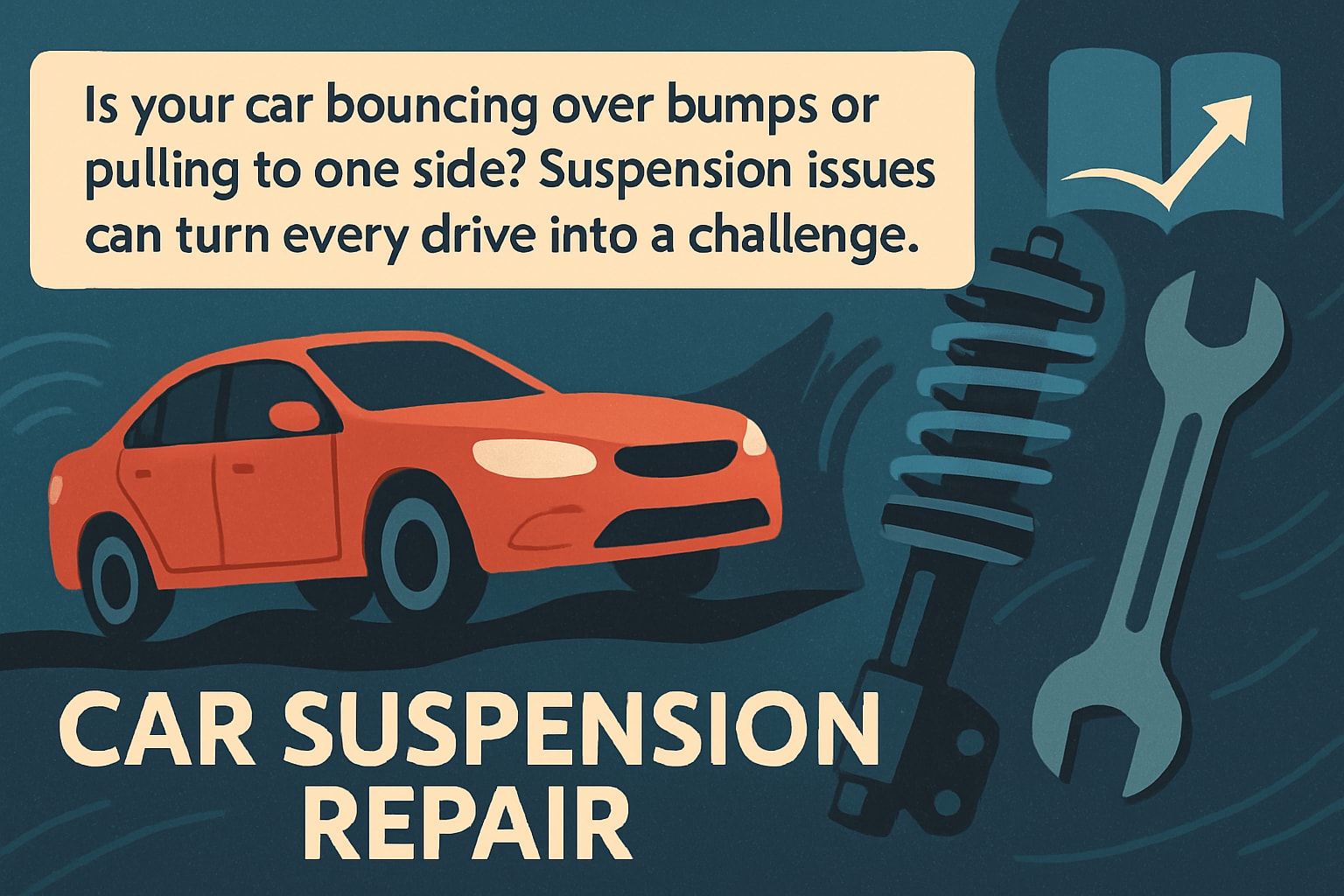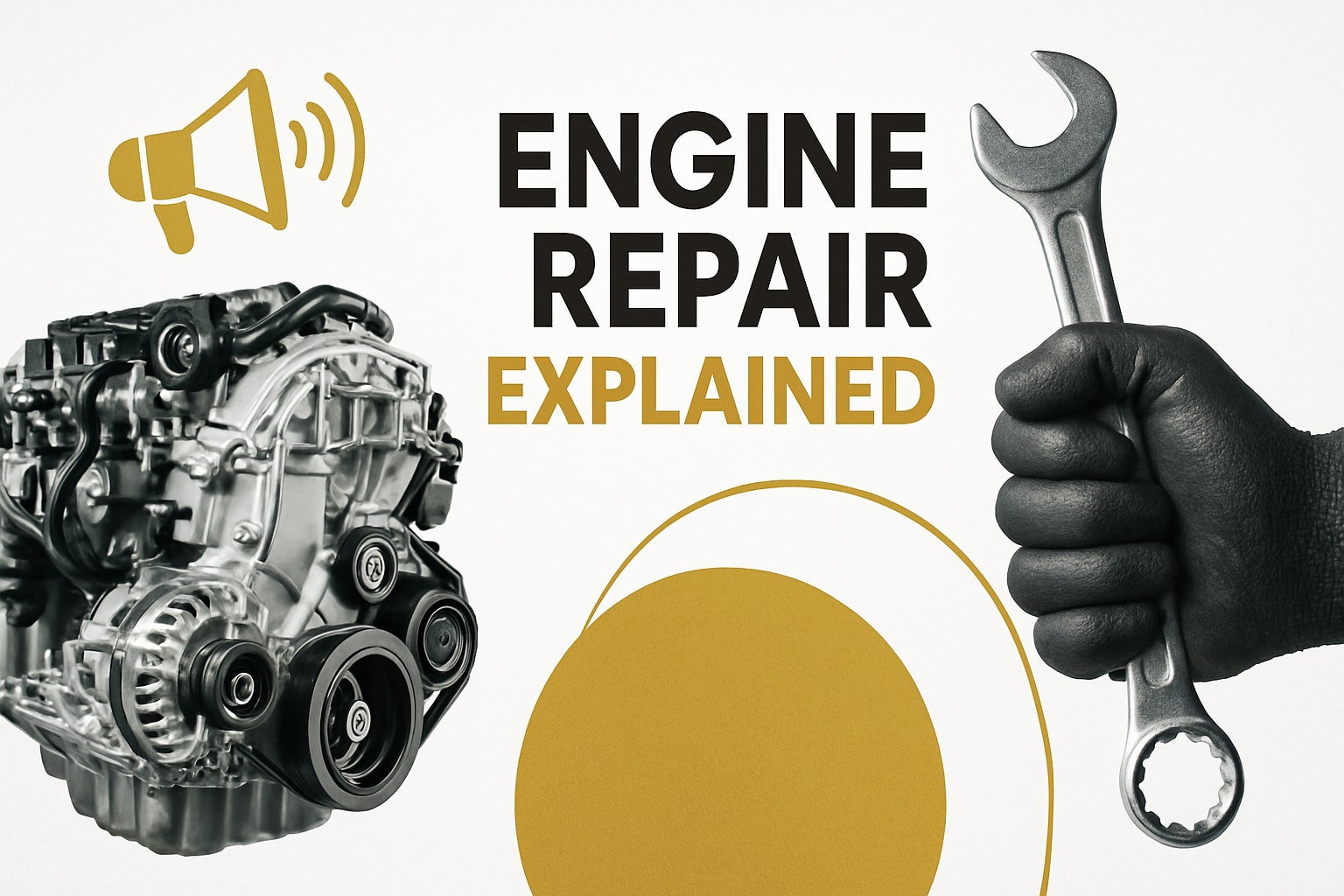Is your vehicle bouncing, swaying, or making odd sounds when you hit a bump? You are not alone. Auto suspension repair is one of the most common reasons drivers visit the shop each year.
This expert guide for 2025 gives you everything you need to know about auto suspension repair, covering components, troubleshooting steps, and the latest techniques for every type of driver.
We will break down the basics, highlight warning signs, compare repair versus replacement, and share practical tips—whether you are a DIY enthusiast or prefer professional help. Get ready for smoother, safer driving.
Understanding Auto Suspension Systems
Auto suspension repair is fundamental for every driver’s safety and comfort. The suspension system absorbs shocks, keeps tires in contact with the road, and maintains vehicle stability. Modern suspensions use advanced materials and designs to smooth out even the roughest roads. According to the NHTSA, nearly 10% of vehicle control complaints are linked to suspension issues. Clearly, a well-maintained suspension is essential for both secure handling and a comfortable ride. If you want to explore professional options, the Suspension Repair Service Overview offers valuable insight into expert repair solutions.
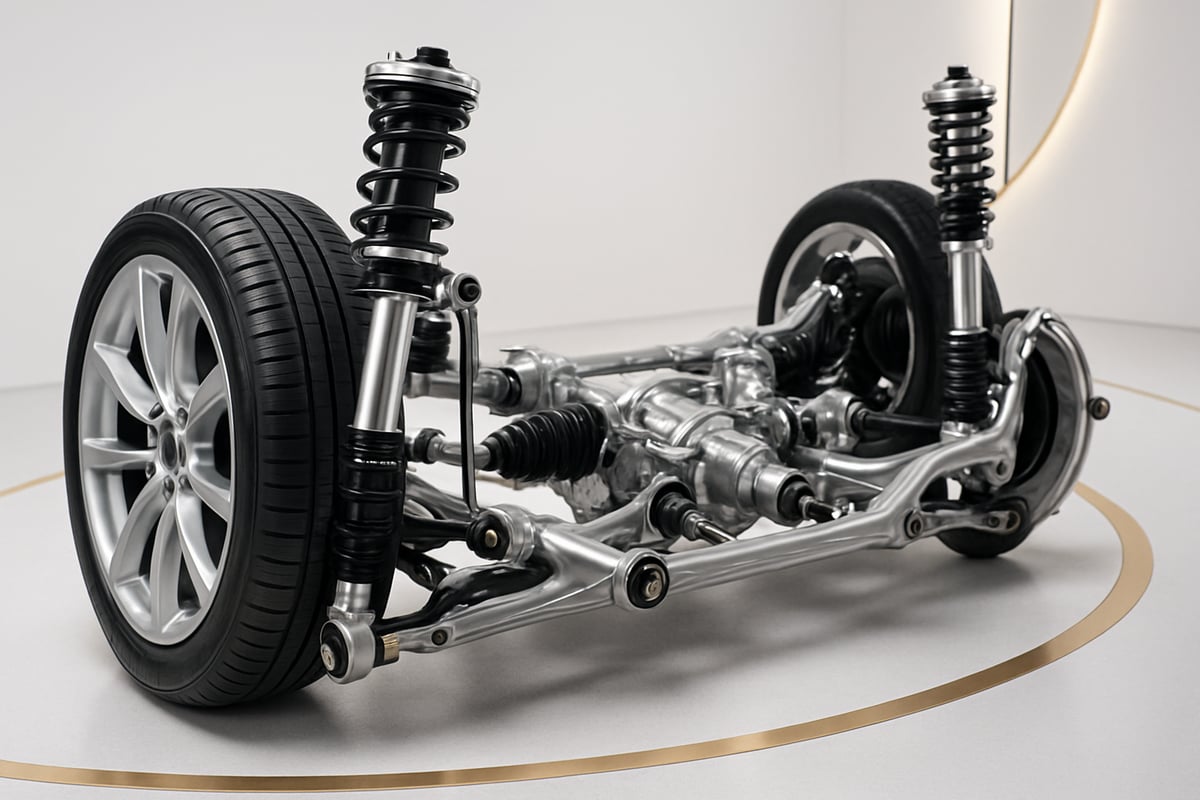
The Role of Suspension in Vehicle Safety and Comfort
The suspension system’s primary job is to absorb bumps and vibrations, keeping your ride smooth and stable. It ensures tires maintain firm contact with the road, which is crucial for safe braking and steering. Advanced suspension designs in 2025 offer better handling and ride quality than ever before. Auto suspension repair is not just about comfort—it’s a vital part of vehicle control and accident prevention.
Main Components of a Suspension System
A typical suspension system consists of shocks, struts, control arms, springs, bushings, ball joints, sway bars, and tie rods. Each part plays a unique role:
| Component | Function |
|---|---|
| Shocks/Struts | Absorb energy from bumps |
| Springs | Support vehicle weight |
| Control Arms | Connect wheels to frame |
| Bushings | Reduce friction and noise |
| Ball Joints | Allow pivoting for steering |
Front and rear suspensions can differ. For example, MacPherson struts are common in sedans, while European luxury cars often feature air suspension. Understanding these parts is the first step in auto suspension repair.
Types of Suspension Systems in 2025
The landscape of suspension systems has evolved rapidly. Traditional coil and leaf spring setups are still found in many vehicles. However, 2025 brings a surge in modern systems like air suspension, adaptive damping, and magnetic ride control. Many premium vehicles now feature electronically controlled or semi-active suspensions, which automatically adjust to road conditions. Identifying your vehicle’s system is critical before starting any auto suspension repair.
How Suspension Interacts with Steering and Brakes
Suspension, steering, and braking systems work together to ensure safe, predictable handling. For example, worn ball joints—a common auto suspension repair concern—can impact steering response and increase braking distance. According to Firestone, a faulty suspension system may increase stopping distance by up to 20%. This interconnectedness means that suspension problems often affect multiple aspects of vehicle performance.
Common Suspension Problems and Causes
Some of the most frequent issues requiring auto suspension repair include worn shocks or struts, broken springs, leaking components, and damaged bushings. Causes range from potholes and rough roads to simple age and corrosion. Overloading your vehicle or skipping routine maintenance can accelerate wear. For instance, Los Angeles roads are notorious for causing premature suspension damage, making regular inspections even more important.
Signs Your Suspension Needs Repair
Is your car suddenly making odd noises or feeling unstable on the road? Knowing when to consider auto suspension repair is crucial for keeping your vehicle safe and comfortable. Catching problems early can prevent costly breakdowns and ensure you stay in control behind the wheel.

Warning Signs and Symptoms
Several warning signs can point to the need for auto suspension repair. Listen for unusual noises like clunks, squeaks, or rattles when driving over bumps. If your car bounces excessively or sways during turns, this often signals worn shocks or struts. Pulling to one side, uneven tire wear, or a steering wheel that feels off-center are also red flags. Notice “nose diving” when braking? Both NAPA and Firestone highlight this as a classic indicator of suspension trouble. Visual cues such as leaking fluid on shocks or struts further suggest immediate attention is needed. For a deeper dive into common symptoms and solutions, check out Brake and Suspension Repair Insights.
How to Perform a Basic Suspension Check
You can spot many suspension issues at home with a quick inspection. Start by parking your car on level ground. Examine all four tires for uneven wear patterns, which may signal underlying auto suspension repair needs. Push down firmly on each corner of the car. The vehicle should bounce once, then settle—repeated bouncing points to worn shocks. Look for visible damage, like cracked bushings or leaking components. If you notice any warning signs, it is wise to consult your owner’s manual or seek expert help. While DIY checks catch many problems, complex repairs should be left to professionals.
The Risks of Ignoring Suspension Issues
Ignoring auto suspension repair can have serious consequences. Poor handling increases your risk of accidents, especially in emergency maneuvers. Worn suspension parts accelerate tire and brake wear, leading to higher long-term costs. Data shows that neglected suspension can reduce your vehicle’s lifespan by up to 15 percent. Firestone emphasizes that unresolved problems compromise both ride comfort and passenger safety. Timely repairs not only protect your investment but also ensure a smoother, safer driving experience.
When to Seek Professional Diagnosis
Some suspension symptoms go beyond what you can safely diagnose at home. Persistent vibrations, steering play, or repeated dashboard warning lights indicate the need for professional evaluation. Modern vehicles often use advanced suspension systems, such as adaptive or air suspensions, which require specialized tools and knowledge for accurate auto suspension repair. If your car is equipped with electronic controls or you notice complex issues, schedule a visit with a certified technician. Expert diagnostics help you avoid misdiagnosis and guarantee the right fix for your suspension system.
Step-by-Step Suspension Repair Guide
Ready to tackle auto suspension repair with confidence? This guide walks you through each step, from preparation to final checks. Whether you are a DIY enthusiast or simply want to understand the process before hiring a professional, following these instructions ensures a safer, smoother outcome.
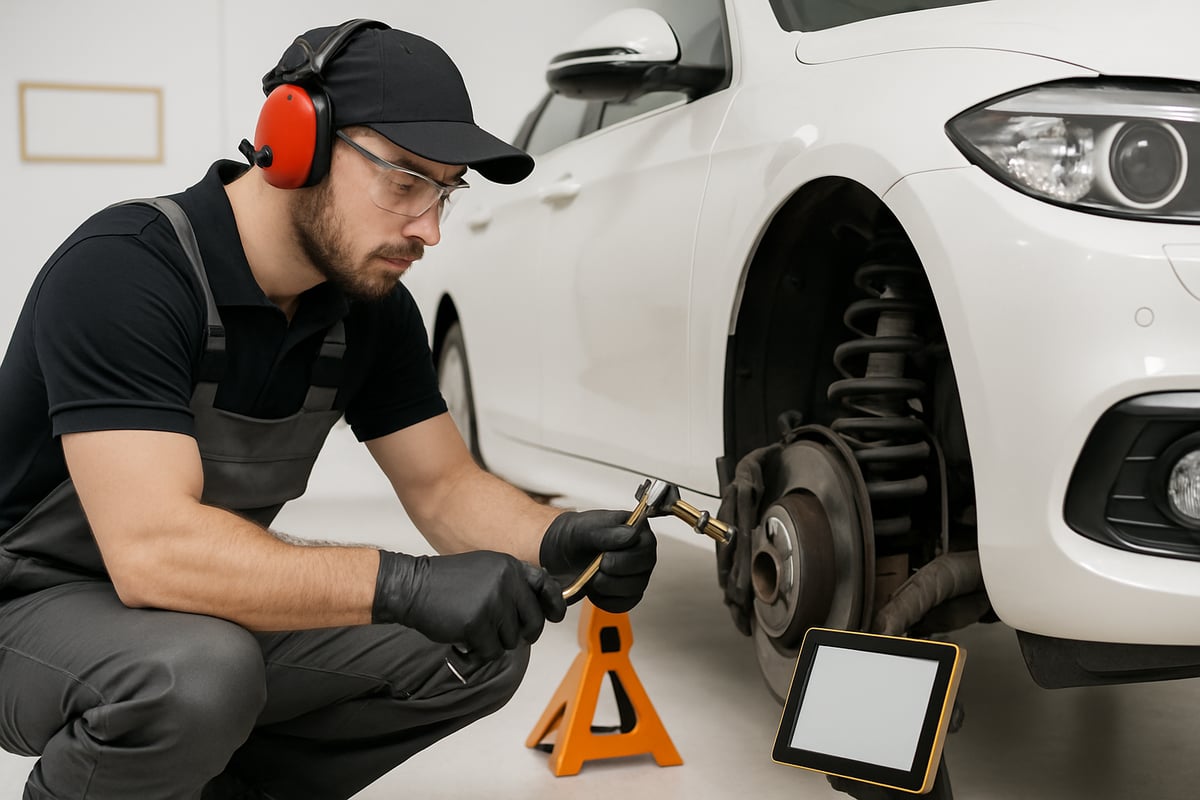
Preparing for Suspension Repairs
Before starting any auto suspension repair, proper preparation is crucial. Gather essential tools such as jack stands, wrenches, a spring compressor, and safety gear like gloves and goggles. Make sure your workspace is clean and well-lit to minimize risks.
Review your vehicle’s owner’s manual or a trusted repair database for model-specific procedures. Suspension layouts can vary, so knowing the exact type you are working on helps prevent errors. Always use jack stands to securely support the vehicle, never rely on a hydraulic jack alone.
Organize your tools before you begin. Label fasteners and small parts to avoid confusion during reassembly. If you are new to auto suspension repair, consider taking photos at each stage for reference. Safety is non-negotiable—double-check all supports before getting under the car.
Diagnosing the Problem: A Chronological Approach
Accurate diagnosis is the foundation of effective auto suspension repair. Start with a test drive, noting any noises, swaying, vibrations, or instability. Pay attention to how the vehicle responds to bumps and turns.
Next, perform a visual inspection. Look for leaks, damaged or rusted components, and uneven tire wear. Examine bushings, ball joints, and mounts for excess play or visible deterioration. For vehicles with electronic or adaptive suspension, use a diagnostic scanner to retrieve any stored fault codes.
Luxury brands like Mercedes and BMW often require advanced scan tools for thorough evaluation. If you lack these tools or experience complex issues, consider seeking Professional Diagnostic Services to ensure pinpoint accuracy. Proper diagnosis prevents unnecessary repairs and saves time.
Replacing Shocks and Struts
When shocks or struts are the source of trouble, follow these steps for a successful auto suspension repair. Begin by loosening the wheel lugs, raising the vehicle, and removing the wheel. Identify and disconnect any related components, such as sway bar links or brake line brackets.
With the spring compressor, safely compress the coil spring if needed. Remove the old shock or strut, paying close attention to mounting points and hardware. Install the new unit, ensuring it matches the original’s specifications.
Torque all fasteners to manufacturer-recommended values. Reassemble the components in reverse order. For best results, replace shocks and struts in pairs (left and right) to maintain balanced handling. After installation, check alignment and adjust if necessary to protect tire life and ride quality.
Repairing or Replacing Springs and Bushings
Auto suspension repair often involves springs and bushings, especially if you notice sagging or uneven ride height. Inspect springs for cracks or breaks and bushings for signs of wear, such as splitting or excessive movement.
To replace coil springs, use a spring compressor and follow all safety precautions. Remove the damaged spring, compare it to the replacement, and install the new one securely. For bushings, press out the old units and lubricate new bushings before seating them in place.
Air suspension systems may require recalibration after replacing springs. Always test the system for leaks or electronic faults before finishing. Proper spring and bushing maintenance restores stability and prevents premature tire and component wear.
Ball Joint and Control Arm Repairs
Ball joints and control arms are vital for precise steering and suspension movement. Common symptoms of failure include knocking sounds, loose steering, or uneven tire wear. During auto suspension repair, inspect these parts for excessive play, torn boots, or rust.
To replace a ball joint, detach the control arm and use a ball joint press to remove the faulty unit. Install the new joint, ensuring it is seated correctly. Control arms may be replaced as an assembly if bushings or the arm itself are damaged.
Take care to align all mounting points and torque fasteners to specifications. After repair, a professional alignment is recommended to restore handling and tire performance. Reliable ball joints and control arms are essential for safe driving.
Final Checks and Test Drive
Before considering your auto suspension repair complete, conduct thorough final checks. Confirm all bolts, nuts, and brackets are tight and secure. Double-check connections for brake lines and electronic sensors.
If you worked on any steering or alignment components, schedule a professional alignment service. Perform a careful test drive, listening for unusual noises and feeling for any lingering instability. Check ride height and steering response.
A successful repair should result in a quiet, stable, and comfortable ride. If issues persist, revisit your steps or consult a certified technician. Regular post-repair inspections help maintain safety and extend vehicle life.
Suspension Repair vs. Replacement: Making the Right Choice
Choosing between repair and replacement is a pivotal step in any auto suspension repair process. Understanding when each option is appropriate can save money, extend the life of your vehicle, and ensure your safety on the road. Let’s break down the decision-making process and highlight what you need to consider.
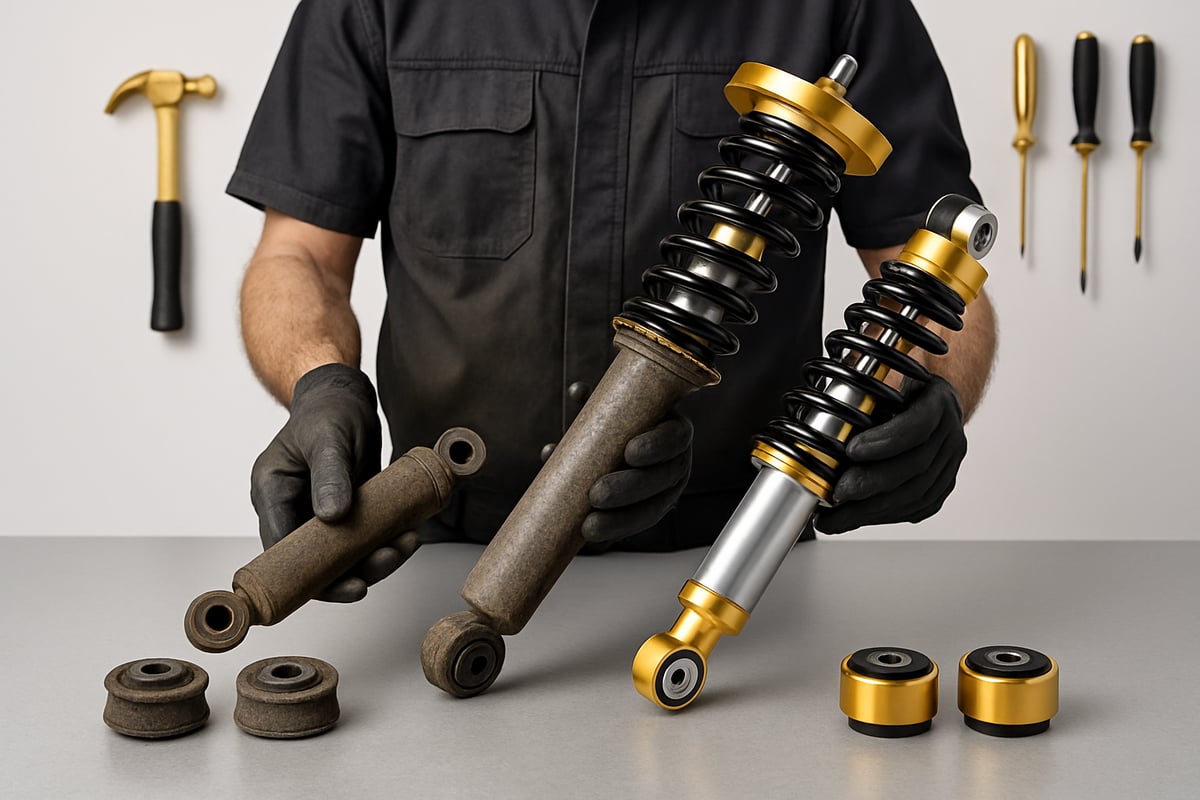
When Repair Is Sufficient
Sometimes, auto suspension repair means addressing just one or two problem areas rather than overhauling the entire system. If you notice minor wear, such as a single worn bushing or a leaking shock absorber, targeted repairs are often enough. This approach is especially practical for older vehicles or those with isolated issues.
Opting for repair is cost-effective and can be a temporary solution, particularly if your vehicle is not subjected to heavy loads or rough driving conditions. For example, replacing a damaged bushing instead of the whole control arm can restore proper function and save on parts and labor. Always evaluate whether the problem is limited in scope before committing to more extensive work.
When Full Replacement Is Necessary
There are situations where a complete replacement is the only safe and effective solution. If multiple components are worn, there is severe rust or corrosion, or if your suspension has suffered structural damage, replacement is essential. Upgrading to a modern suspension system, such as air or adaptive technology, is also a popular choice among luxury and performance vehicle owners.
Replacing all four shocks or struts is recommended for high-mileage vehicles to maintain balanced handling and safety. If you are considering performance improvements, explore options like Suspension and Handling Upgrades, which can transform your driving experience and add value to your investment.
Evaluating Costs and Value
Budget is a significant factor in any auto suspension repair decision. Typical repair costs range from $300 to $1,200 or more, depending on the extent of work and the type of vehicle. Choosing between OEM and aftermarket parts involves weighing warranty coverage, compatibility, and long-term reliability.
Investing in quality parts and skilled labor ensures safety and longevity. Both Firestone and NAPA recommend prioritizing reputable brands for peace of mind. Ultimately, balancing upfront expenses with the value of long-lasting performance is key to making the right choice for your vehicle.
DIY vs. Professional Service
Auto suspension repair can be a rewarding project for experienced enthusiasts, especially when tackling simpler jobs like shock or bushing replacement. However, advanced systems—such as air, adaptive, or electronically controlled suspensions—often require specialized tools and technical expertise.
If you drive a luxury vehicle or encounter complex symptoms, professional service is usually the best route. Many high-end car owners in areas like Beverly Hills prefer mobile experts for added convenience and assurance. Remember, improper repairs can lead to safety risks and higher costs down the line, so always assess your skill level honestly.
Latest Suspension Technologies and Trends for 2025
The landscape of auto suspension repair is rapidly evolving as new technologies redefine what drivers can expect from their vehicles. In 2025, both luxury and mainstream models are benefiting from next-generation suspension systems, advanced diagnostics, and eco-friendly components. Staying informed about these developments is essential for effective auto suspension repair and long-term vehicle performance.
Advances in Suspension Systems
In 2025, auto suspension repair increasingly involves semi-active and fully active suspension systems, especially in electric and luxury vehicles. These advanced setups use sensors and onboard computers to adjust ride comfort and handling in real time. Magnetic ride control, once exclusive to high-end sports cars, is now featured in mid-range and premium models. According to the Automotive Suspension Systems Market Report 2025, electrification and adaptive technology are driving innovation in the industry. As a result, auto suspension repair specialists must be proficient in both traditional and electronic systems to meet the needs of modern vehicles.
Smart Diagnostics and Predictive Maintenance
Modern auto suspension repair relies on integrated sensors that monitor component health and alert drivers to potential issues before they escalate. Predictive maintenance uses real-time data and analytics to anticipate failures, allowing for timely interventions that minimize downtime. By 2025, over 40% of new vehicles are equipped with some form of suspension health monitoring, making diagnostics more accurate and less invasive. This technology empowers technicians and owners alike to schedule repairs proactively, reducing the risk of unexpected breakdowns and extending the lifespan of suspension components.
Eco-Friendly Suspension Components
Sustainability is now a key factor in auto suspension repair. Manufacturers are incorporating lightweight, recyclable materials such as aluminum and advanced composites into springs, control arms, and bushings. These innovations not only improve fuel efficiency but also help reduce overall vehicle emissions. For example, many 2025 European sedans now feature aluminum control arms, which offer strength without the extra weight. Choosing eco-friendly parts during auto suspension repair supports environmental goals and can also enhance vehicle performance.
Retrofitting and Upgrading Older Vehicles
Retrofitting classic cars and older trucks with modern suspension technology is becoming more accessible. Aftermarket kits allow for the installation of air suspension or adaptive systems, providing improved ride quality and handling. When considering auto suspension repair for older vehicles, it is important to assess compatibility and professional installation requirements. Upgrading can add value and comfort, but a thorough evaluation ensures the right fit and optimal results for both daily drivers and automotive enthusiasts.
Preventative Maintenance and Longevity Tips
Regular preventative care is essential for extending the life of your vehicle’s suspension. By following a few expert-backed strategies, you can minimize costly auto suspension repair needs and keep your ride smooth for years to come.
Routine Inspection and Service Intervals
Consistent inspection is the foundation of effective auto suspension repair and overall vehicle health. Experts recommend checking your suspension system every 12,000 to 15,000 miles or at least once a year. During these inspections, focus on key components like shocks, struts, bushings, ball joints, and alignment.
Look for signs of wear, such as leaking fluid, cracked bushings, or rusted mounts. Comparing your system to industry standards, as outlined in the Top 25 Global Vehicle Suspension Systems Analysis, can help you understand the latest benchmarks for performance and reliability.
A proactive approach to inspection not only ensures safety but also reduces the risk of unexpected auto suspension repair down the road.
Protecting Suspension from Road Hazards
Road hazards are a leading cause of premature suspension issues and can quickly escalate the need for auto suspension repair. Urban drivers, especially in cities like Los Angeles, encounter potholes, rough pavement, and construction zones daily.
To protect your suspension, slow down when approaching uneven surfaces, avoid overloading your vehicle, and use protective coatings to guard against corrosion. Staying alert and defensive behind the wheel significantly minimizes damage from road hazards.
Small adjustments in driving habits, combined with regular visual checks, can make a substantial difference in the frequency of auto suspension repair over your vehicle’s lifespan.
Proper Tire Care and Alignment
Tire maintenance is directly linked to the health of your suspension system and can prevent unnecessary auto suspension repair. Rotating your tires every 5,000 to 7,500 miles helps distribute wear evenly. Regularly check tire pressure and tread depth to ensure optimal performance.
Alignment is another critical factor. Poor alignment places extra stress on suspension components, leading to premature wear. Data shows that misalignment can reduce tire lifespan by up to 30 percent, highlighting the importance of prompt correction.
Spotting uneven tire wear early on is one of the simplest ways to catch potential auto suspension repair needs before they become major problems.
Lubrication and Cleaning Practices
Proper lubrication and cleaning routines are vital for preventing excessive wear and extending the life of your suspension. Lubricate joints and bushings with high-quality products designed for your vehicle type, especially if you own a luxury or performance model.
Clean the undercarriage regularly to remove dirt, salt, and other corrosive materials that can accelerate deterioration. Focus on suspension mounts, arms, and connectors, as these areas are most vulnerable to buildup.
By prioritizing regular lubrication and cleaning, you can dramatically reduce the frequency and severity of auto suspension repair, ensuring your vehicle remains safe and comfortable on the road.
After learning how crucial a healthy suspension is for your car’s safety and comfort, it’s clear that timely repairs make all the difference—especially if you drive a high-end model through Los Angeles’s challenging roads. If you’ve spotted warning signs, or you want the peace of mind that comes with expert diagnostics and dealership-level care right at your doorstep, you don’t have to wait. Revera Mobile Mechanic specializes in advanced suspension repairs for luxury vehicles, so you can trust your ride is in skilled hands.
Book service!




